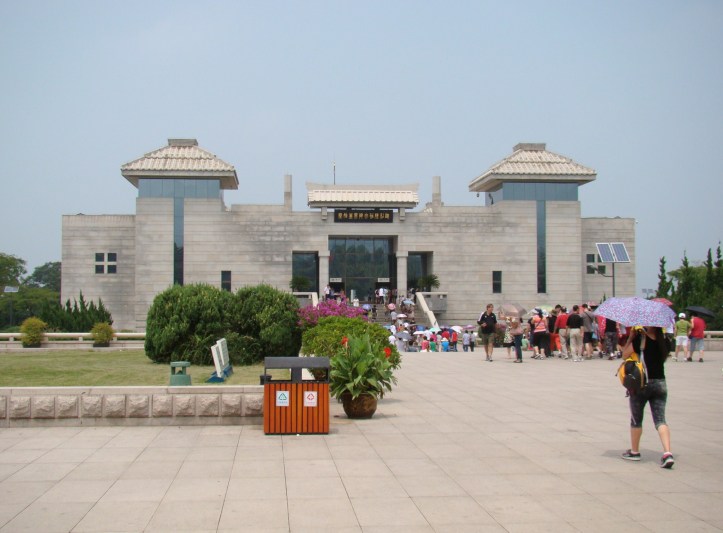
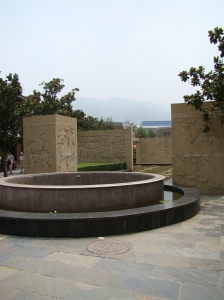
The Terracotta Army or the “Terra Cotta Warriors and Horses”, is a collection of terracotta sculptures depicting the armies of Qin Shi Huang, the first Emperor of China. It is a form of funerary art buried with the emperor in 210–209 BC and whose purpose was to protect the emperor in his afterlife.
The Terra Cotta Warriors and Horses are the most significant archeological excavation of the 20th century.
The figures, dating from around the late third century BC, were discovered in 1974 by a local farmer, 83 year old Mr Yong while digging a well on his farm. Seeing this Terracotta Army was very high on my wish-list and I was super excited at the prospect of actually getting to stand next to them!
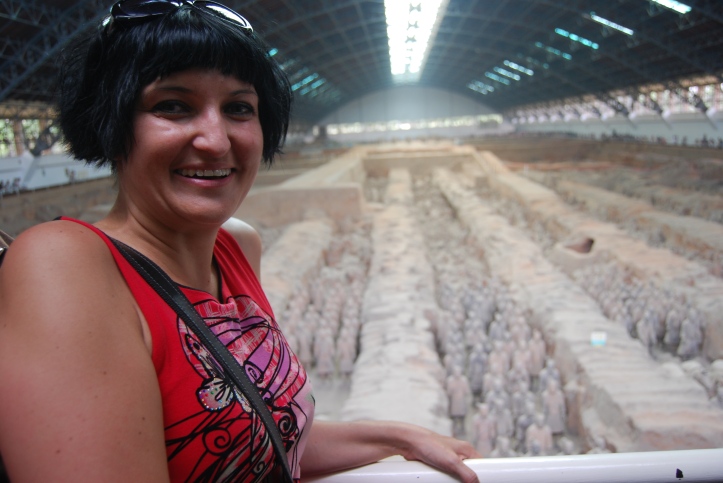
It was a blistering hot and humid day and sweat was dripping down my back before we reached the halls housing the Terracotta Warriors. Inside the hall is was a bit cooler than outside but it was packed with people so still felt a bit stifling.
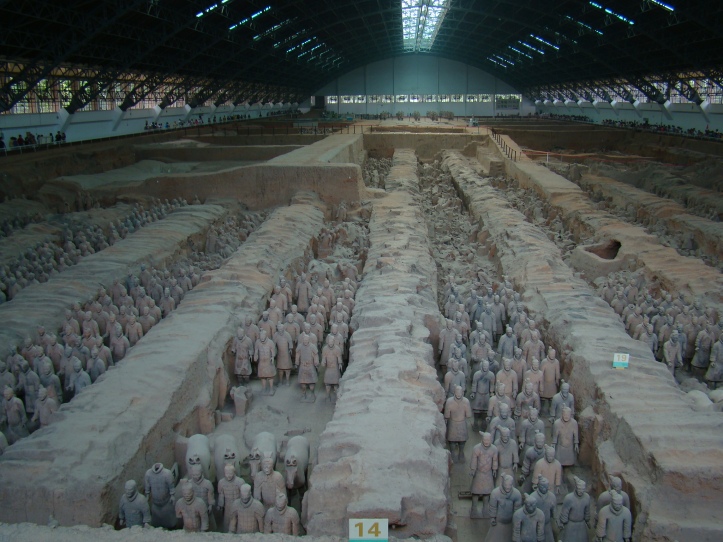
Setting eyes on this magnificent army took my breath away! It’s shocking to think that all of this was built with the express purpose of being buried with the king when he died. It was amazing seeing the rows and rows of warriors lined up in that huge hall, knowing that we are actually only seeing a fraction of the whole army.
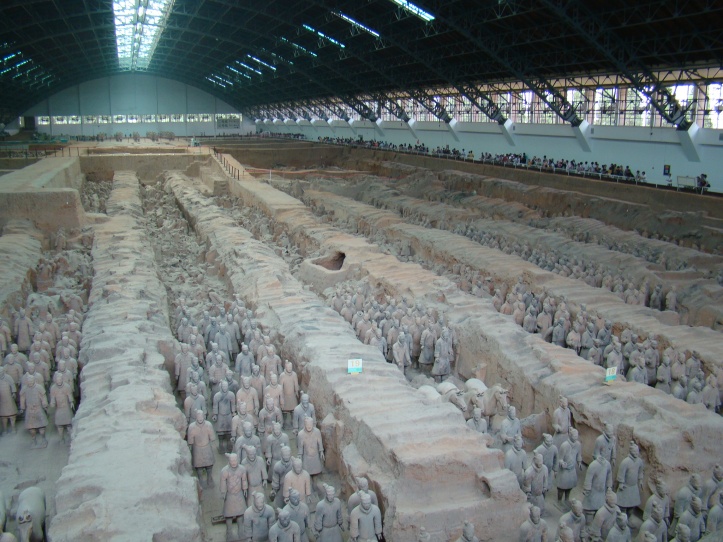
The figures vary in height according to their roles, with the tallest being the generals. The figures include warriors, chariots and horses. Current estimates are that in the three pits containing the Terracotta Army there were over 8,000 soldiers, 130 chariots with 520 horses and 150 cavalry horses, the majority of which are still buried. Other terracotta non-military figures were also found in other pits and they include officials, acrobats, strongmen and musicians.

There are four main pits associated with the terracotta army. These pits are located about 1.5 km east of the burial mound and are about 7 meters deep. The army is placed as if to protect the tomb from the east, where all the Qin Emperor’s conquered states lay.
In one pit, long columns of warriors, reassembled from broken pieces, stand in formation. With their topknots or caps, their tunics or armored vests, their goatees or close-cropped beards, the soldiers exhibit an astonishing individuality.
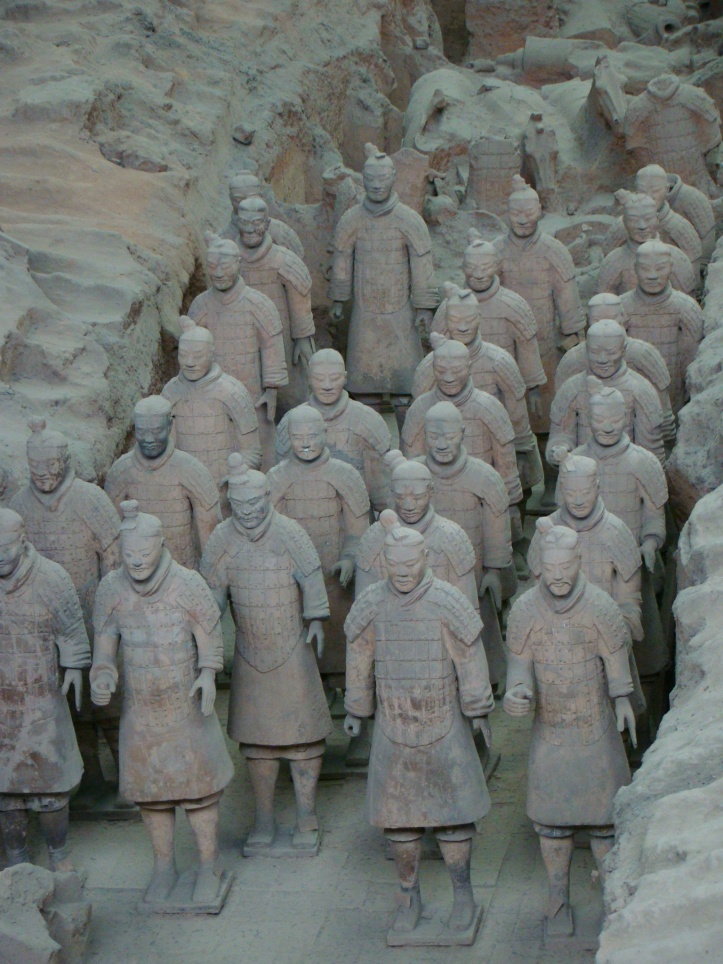
A second pit inside the museum demonstrates how they appeared when they were found: some stand upright, buried to their shoulders in soil, while others lie toppled on their backs, alongside fallen and cracked clay horses. The site ranks with the Great Wall and Beijing’s Forbidden City as one of the premier tourist attractions within China.

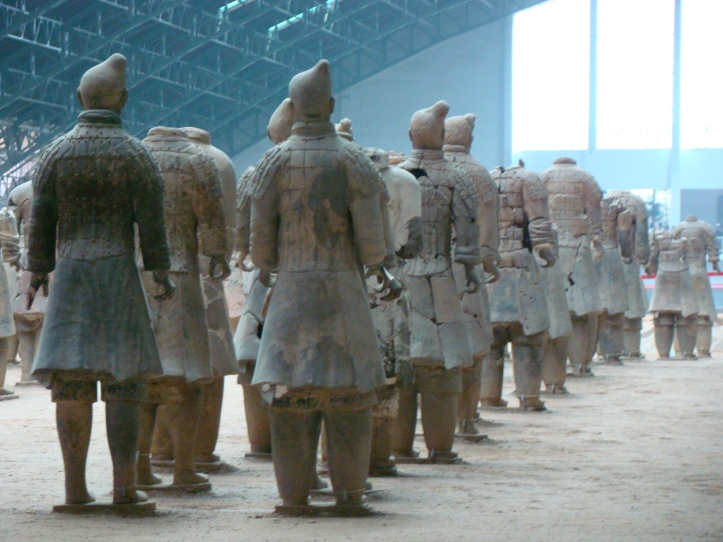
Many of the figures originally held real weapons of the time, such as bronze swords, longbows, arrows, spears, dagger-axes, and other long-shafted weapons. The weapons were treated to make them resistant to rust and corrosion, so that even after being buried for over 2,000 years they were still sharp.
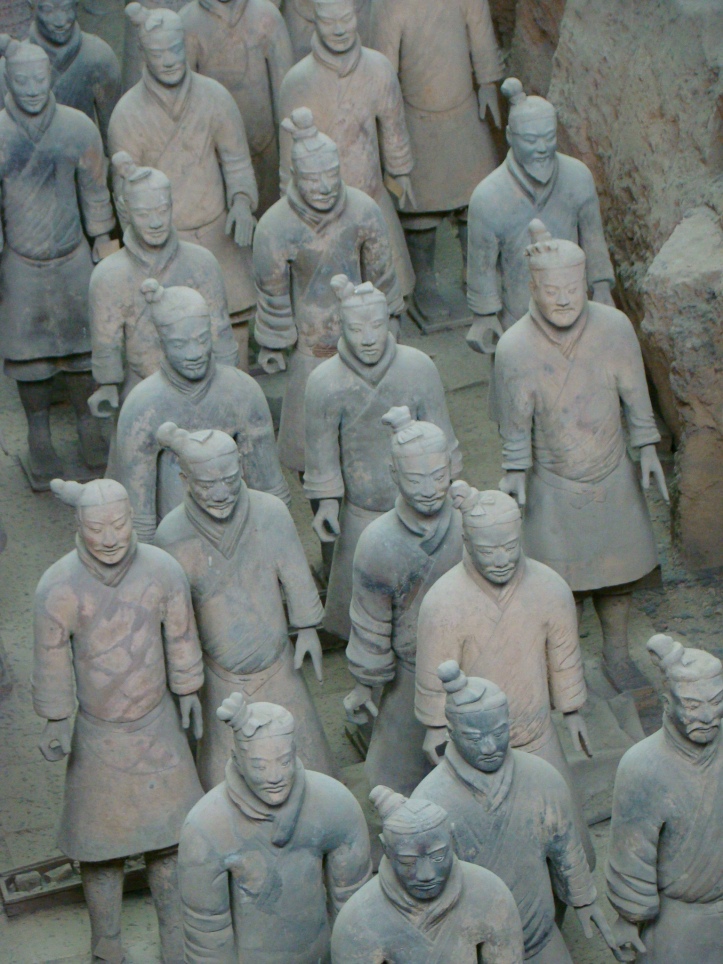
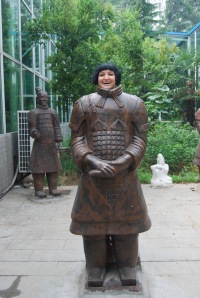
Inside the Terracotta museum we got to watch a movie about how and why they were created. According to historians work on this mausoleum began in 246 BC soon after Emperor Qin ascended the throne (then aged 13), and the full construction later involved 700,000 workers. It took 11 years to finish. It is speculated that many buried treasures and sacrificial objects had accompanied the emperor in his after life. Most of the workmen died from exhaustion or were killed for secrecy reason after finishing their work.
For archaeologists, one indicator that Qin rule had collapsed suddenly was the extensive damage to the terra cotta army. As order broke down, marauding forces raided the pits where clay soldiers stood guard and plundered their real weapons. Raging fires, possibly set deliberately, followed the ransacking, weakening support pillars for wooden ceilings, which crashed down and smashed the figures. Some 2,000 years later, archaeologists discovered charring on the walls of one pit.
Mr Yong was at the museum so we all bought a Terracotta Army guide book which he then signed.
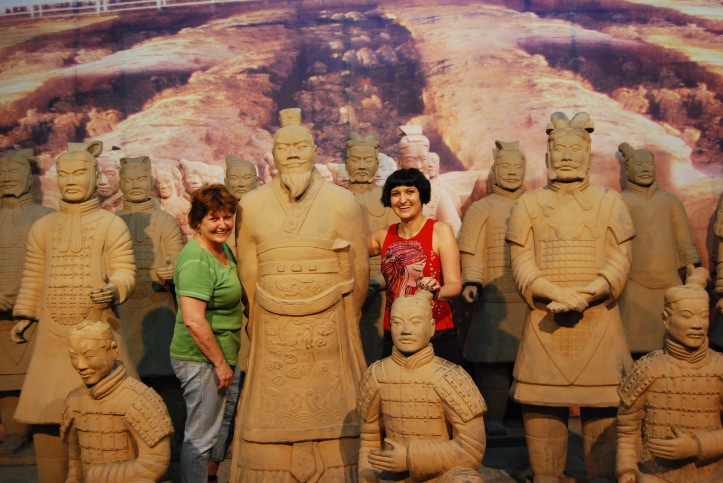
We were told the following little anecdote by our tour guide and I still smile when I imagine the situation. Mr Yong can’t really speak much English and had to meet President Clinton while he was touring China. They taught him a few English phrases he was sure to use: He was to9ld to introduce himself, say nice to meet you, how are you? And was assured that the President would reply good and you? To which he should reply: Me too.
But unfortunately he mispronounced it a bit and ended up saying: Nice to meet you, who are you? To which Clinton answered: I’m Bill, Hilary’s husband and you? Mr Yong promptly answered: Me too!!
Even though it’s a bit crowded and touristy now this was an amazing experience and a definite must see if you ever have the chance.
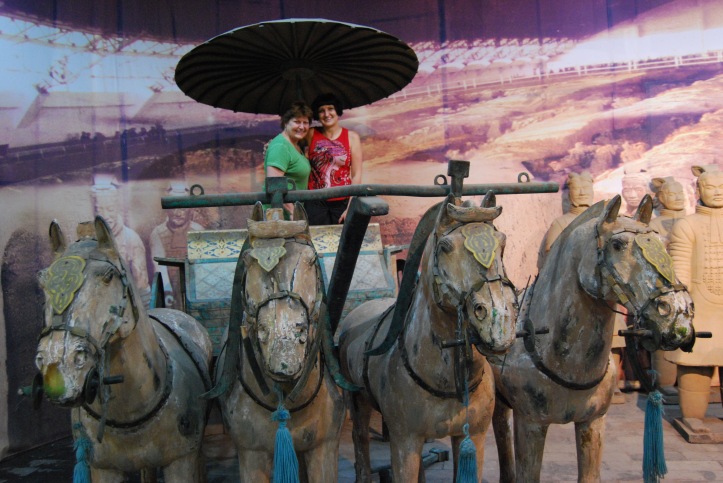
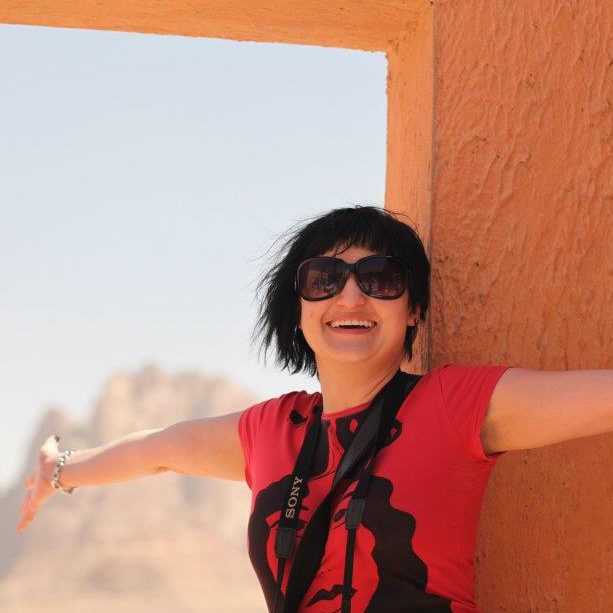














I recently watched a documentary about these soldiers. Fascinating stuff. Love your entry and the great photos!
LikeLike
Thanks! It was an amazing experience!
LikeLike
this is just amazing! thanks for sharing!
LikeLike
Thanks for visiting my journey!!
LikeLike
Thanks for sharing your trip! I also saw the exhibit in Toronto, which was good, but NOTHING like the real thing! I would love to see them.
LikeLike
Thanks Terri! Yes, it is amazing and definitely a breathtaking experience seeing this huge army lined up in these pits.
LikeLike
The cavalryman and his mount:
never saw this detail!
P.S.:
you made me smile with:
“Me and mom
on a Terracotta chariot!!”
LikeLike
Thanks, we had such a fabulous time together and getting to see the Terracotta army together was an amazing experience.
LikeLike
Incredible … I loved this post. Thanks
LikeLike
Thanks Isadora!!
LikeLike
That is some army, still standing tall even after centuries!! 🙂
LikeLike
I agree, its an amazing army, immortalized in terracotta
LikeLike
how very extraordinary … brilliant photos, you really give the feeling of being there and enjoying the experience!
LikeLike
Thank you!! It was such an amazing expereince for us and I am glad that I am able to share it.
LikeLike
So much history there!
LikeLike
I think China has such a rich and colourful history, I would love to read up on it a bit more before I visit again.
LikeLike
I’ve never been. I’d like to learn more about China too!
LikeLike
It was massive, to say the least… Great photos!
LikeLike
Thanks Amy! Yes, as you know it is huge and quite hard to capture this vast army on film.
LikeLike
You’ve got some amazing pictures of the terracotta army.
LikeLike
Thanks Chrisstov. They are so amazing that I think it is quite difficult to take a “bad” picture of these warriors.
LikeLike
This is a very interesting post about Teracotta Warriors. I just mentioned this to my class this week as we’re learning about Qin Shi Huang’s rule in ancient China! You’re so lucky to have visited the place! (Thumbs up!) 🙂
LikeLike
Thanks Coco Di! I think learning about his rule and the great history of China must be very interesting.
LikeLike
I especially love the close ups of the statues. What a great place to visit!
LikeLike
Thanks AJ! It was such a great place that I ended up taking way too many photos!!
LikeLike
Amazing! I would love to see these! Great pictures!
LikeLike
Thanks Sue! It was an amazing expereinece getting to see this magnificent army immortalized in terracotta.
LikeLike
Awesome! I’ve always wanted to see the soldiers ever since I learned about them in high school! Saw a few of them when they came to London and later Washington…but, that looks amazing! One day, I’ll go.
LikeLike
Seeing them all lined up in this huge hall is definitely an amazing experience!! I do hope you get the chance to go and see them!
LikeLike
Wow! We saw the exhibition when it came to the Rom here in Toronto and we were impressed. Nothing like what you saw, however. You have shown us how vast it really was.
LikeLike
They are amazing! Glad you got to see some of them Colline.
LikeLike
Lovely Pictures. Unimaginable!
LikeLike
Thank you! it is definitely a breathtaking sight weeing it in person.
LikeLike
Amazing! I saw a sampling of the Terracotta Warriors during a traveling exhibition in London at the British Museum, but it would so cool to see them in person in their original setting!
LikeLike
Seeing them all lined up in this huge hall is definitely an amazing experience!! If you ever get the chance you shouold definitely go and see them!
LikeLike
This looks incredible! Do you think the faces on each warrior are the faces of the person that made it? Great photos, btw
LikeLike
Thanks Megan. We were told that the faces were actually the faces of his real army, so each warrior actually existed in real life before being immortalized in terracotta!
LikeLike